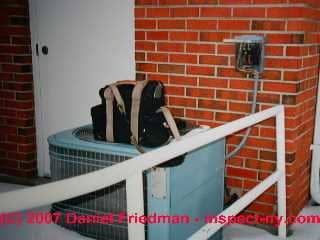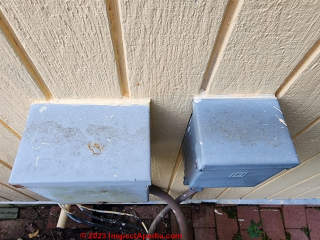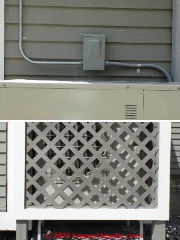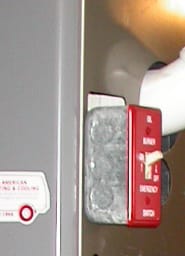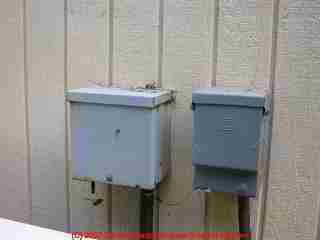 A/C or Heat Pump Compressor / Condenser Disconnect Switch
A/C or Heat Pump Compressor / Condenser Disconnect Switch
Electrical
Code & Distances
- POST a QUESTION or COMMENT about how to find, identify, & use or troubleshoot each control or switch found on air conditioners or heat pumps.
A/C or Heat Pump Compressor/Condenser Unit Safety Disconnect Switch:
What is the proper location & permitted distance for a safety electrical disconnect switch at or near the outdoor compressor/condenser unit of HVAC systems? What is the requirement for placement, distance, and readily accessible nature of the disconnect or motor controller for equipment operated by an electric motor. U.S. NEC code citations, excerpts, discussion.
This article series explains where to find and how to use the switches and controls for air conditioning and heat pump systems. We list and explain the function of each air conditioner or heat pump control or switch, including providing identification photographs and troubleshooting tips.
InspectAPedia tolerates no conflicts of interest. We have no relationship with advertisers, products, or services discussed at this website.
List of Outside A/C or Heat Pump Service Switches, Fuses, Circuit Breakers
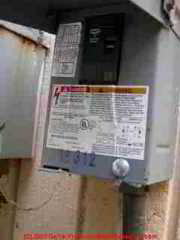
The pair of photographs at page top and just above show the outdoor air conditioner or heat pump compressor/condenser service control switch, in this case a circuit breaker, installed outside at a compressor for a ductless cooling system compressor.
More photographs of a ductless or split system air conditioning system are
[Click to enlarge any image]
Below you will see an air conditioning system compressor/condenser service switch for an outdoor compressor/condenser outdoor unit that was remarkably unsafe.
The photo (below) shows that there was a 240V fused circuit with outdoor fuses in the box, but this close up photograph [Image file] shows that someone has installed 1/2" copper pipes in place of the original fuses.
This might be a dangerous installation, risking fire as well as a burn up of the air conditioning equipment.
But as Mark Cramer contact reference] pointed out, if the circuit were properly protected by breakers or fuses at the main panel, the insertion of metal pipes in these fuse sockets just converts the device from a fuse box to a simple switch. An on-off switch is all that is required for this location and application by electrical codes.
Circuit breaker(s) at the electrical panel protect the circuit supplying power to the air conditioning system. Typically separate circuit breakers (or fuses) power the compressor/condenser unit and the indoor air handler/blower assembly.
In any case, simply installing fuses would restore the proper safety device but it's likely that further testing and diagnosis of the electrical circuit and the compressor/condenser unit will be needed to determine why someone installed copper pipes where fuses belonged in the first place.
When someone converts fuses to a switch in this location it may be because the air conditioning system was frequently blowing the fuses --
someone wanted to force the compressor/condenser to run.
Compressor Service Switch or Disconnect Location & Distance
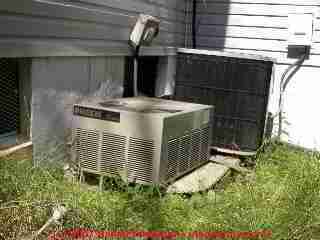 The air conditioning system compressor service switch is located outdoors, at the compressor/condenser unit, typically on a building wall near the outdoor unit,
this switch may be a circuit breaker, a fuse block pull-out, or a simple electrical switch.
The air conditioning system compressor service switch is located outdoors, at the compressor/condenser unit, typically on a building wall near the outdoor unit,
this switch may be a circuit breaker, a fuse block pull-out, or a simple electrical switch.
Service switches permit a service
technician to work safely on the equipment by turning off electrical power to the unit without having to run back and forth
through the building to the main electrical panel.
Where the compressor/condenser service switch is omitted some technicians are tempted to work on equipment while it is electrically "live", and a few of them get shocked.
These switches are required by current electrical
codes but may be absent on old A/C installations.
If no service switch is installed at the compressor/condenser you should have
one installed at the next A/C service call or next electrical work done on the building.
In our photograph the A/C service
switch is very unsafe for two reasons: first, because it is falling off of the wall it may be difficult to operate the switch.
Second, ask yourself, "What happened to the screws that were used to fasten this switch to the building wall?"
We've seen cases of the mounting screws falling into the switch box, causing a short circuit or even a fire. In this particular case the vinyl siding installers pulled the switch loose to install siding and didn't bother to reinstall it.
Air Conditioner / Heat Pump Compressor Condenser Switch Maximum Distance to the Compressor/Condenser Unit Disconnect
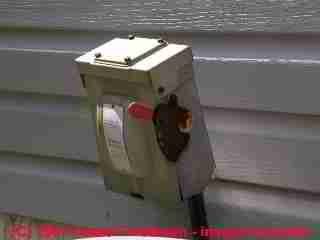 Watch out: our photo shows an outdoor disconnect switch for a condenser unit: it is falling off of the wall. Loose electrical boxes pose fire and electrical s shock hazards. Wires move and connectors may come loose, exposing someone touching the box to fatal electrical shock, and on occasion a screw falling out of the wall and into an outdoor electrical box can cause a short circuit that starts a building fire.
Watch out: our photo shows an outdoor disconnect switch for a condenser unit: it is falling off of the wall. Loose electrical boxes pose fire and electrical s shock hazards. Wires move and connectors may come loose, exposing someone touching the box to fatal electrical shock, and on occasion a screw falling out of the wall and into an outdoor electrical box can cause a short circuit that starts a building fire.
The following details are excerpted from the 2011 edition of the US National Electrical Code / NEC.
NEC 430.102(A) and (B) apply to electric motors driving other equipment such as a non-hermitcally-sealed compressor motor found on some commercial equipment or such as a fan coil unit. I [DF] have encountered these installations at both walk-in coolers and some commercial freezers. NEC 430 includes definitions of readily accessible and of within sight.
NEC 440.13 and NEC 440.14 rules for motor disconnect means apply to typical outdoor HVAC compressor/condenser units while
The two sets of disconnect distance rules are similar.
NEC 440.13 disconnect for room air conditioners or heat pumps - paraphrasing: the air conditioner or heat pump unit disconnect must be within sight from and readily accessible from the unit.
440.13 Cord-Connected Equipment. For cord-connected equipment such as room air conditioners, household refrigerators and freezers, drinking water coolers, and beverage dispensers, a separable connector or an attachment plug and receptacle shall be permitted to serve as the disconnecting means.
Informational Note: For room air conditioners, see 440.63.
For a room air conditioner such as a window-unit, an electrical cord plug that can be simply un-plugged from the electrical receptacle counts as an acceptable disconnect provided the cord is shorter than 6 ft. on a 220VAC unit or less than 10 ft. for a 120VAC unit.
NEC 440.14 disconnect for central or split system air conditioners or heat pumps
- paraphrasing: The air conditioner or heat pump compressor/condenser outside service switch or service disconnect must be readily accessible & within sight of the compressor/condenser unit
440.14 Location. Disconnecting means shall be located within sight from and readily accessible from the air- conditioning or refrigerating equipment. The disconnect- ing means shall be permitted to be installed on or within the air-conditioning or refrigerating equipment.
The disconnecting means shall not be located on panels that are designed to allow access to the air-conditioning or refrigeration equipment or to obscure the equipment name- plate(s).
Exception No. 1: Where the disconnecting means provided in accordance with 430.102(A) is capable of being locked in the open position, and the refrigerating or air-conditioning equipment is essential to an industrial process in a facility with written safety procedures, and where the conditions of maintenance and supervision ensure that only qualified persons service the equipment, a disconnecting means within sight from the equipment shall not be required.
The provision for locking or adding a lock to the disconnecting means shall be installed on or at the switch or circuit breaker and shall remain in place with or without the lock installed.
Exception No. 2: Where an attachment plug and recep- tacle serve as the disconnecting means in accordance with 440.13, their location shall be accessible but shall not be required to be readily accessible.
nformational Note No. 1 : See Parts VII and IX of Article 430 for additional requirements. Informational Note No. 2: See 110.26.
Examples where this exception apply include room air conditioners, home refrigerators or freezers, similar free-standing plug-in cooling appliances.
NEC 440.63 disconnecting means for room air conditioners
gives more guidance for the disconnect for portable devices like room air conditioners
440.63 Disconnecting Means.
An attachment plug and re- ceptacle or cord connector shall be permitted to serve as the disconnecting means for a single-phase room air condi- tioner rated 250 volts or less if
(1) the manual controls on the room air conditioner are readily accessible and located within 1.8 m (6 ft) of the floor, or
(2) an approved manually operable disconnecting means is installed in a readily ac- cessible location within sight from the room air conditioner.
440.64 Supply Cords.
Where a flexible cord is used to sup- ply a room air conditioner, the length of such cord shall not exceed 3.0 m (10 ft) for a nominal, 120-volt rating or 1.8 m (6 ft) for a nominal, 208- or 240-volt rating.
440.65 Leakage-Current Detector-Interrupter (LCDI) and Arc-Fault Circuit Interrupter (AFCI).
Single-phase cord-and-plug-connected room air conditioners shall be provided with factory-installed LCDI or AFCI protection.
The LCDI or AFCI protection shall be an integral part of the attachment plug or be located in the power supply cord within 300 mm (12 in.) of the attachment plug.
Definition of readily accessible & within sight
NEC 430.107 Readily accessible & within sight
means that the disconnect switch is visible from the controlled-device and can be reached and used without having to climb obstacles or use a ladder.
This distance is typically described as within 50 feet (15 meters), and in practice at most residential properties the disconnect is much closer (3-6 ft), on a wall or standard near the compressor/condenser unit.
Within sight of is defined as within 50 feet (15 m) and able to be seen from the component being disconnected (and vice versa). The disconnect also has to be directly accessible, so "seen through a window or over a fence" would not be acceptable as it would not be safe.
Typically there is also a GFCI protected outdoor electrical receptacle within 25 feet of the compressor/condenser, it's likely that those two features will be together at most installations.
We have read reports that some local building code officials may require a closer distance - 3 feet - to the switch.
Note that for the indoor equipment the rule is a bit different. NEC 440.14 permits the air handler disconnect to be on or even inside of a cover at the air handler unit, though in my OPINION on or adjacent-to the unit is safer as it doesn't require opening a panel into the air handler itself (where there could be moving parts or exposed wires) to access the service switch.
Maximum distance between disconnect or controller and an electric motor
NEC 430.102 disconnect for electric motors driving equipment or machinery provides minimum distance requirements for the disconnect for the electric motor or its controller.
NEC 430.102(A) Motor-Controller disconnect
(paraphrasing) the disconnect must be in sight from the controller and must disconnect the controller from its power source. (A controller is defined in NEC 430.81 as the device used to start and stop a motor. )
It's worth noting that for commercial installations OSHA 1910.333 requires that equipment be powered off when being serviced, with the exception that some test procedures will require the equipment to be on. (Additional protection for the worker is required.)
NEC 430.102(B) Motor electrical disconnect
(paraphrasing) the electrical disconnect must be within sight of the motor (and driven machinery operated by the motor). This rule provides safety for workers on equipment that might be switched on or off without power passing through a separate motor controller device.
Where both an electrical disconnect and a separate motor controller are both installed, at least one of these devices capable of turning off the motor itself (and thus turning off the machinery it drives) must be within sight from the motor and must be readily accessible.
Where the electrical motor disconnect is within sight of and readily accessible to both the motor controller and the motor itself and the equipment driven by the motor then the electrical disconnect will satisfy both NEC 430(A) and NEC 430(B).
Exceptions to these US NEC provisions are permitted where applying the provision is not feasible or not safe.
Where there are multiple motor controllers installed, NEC 430.102(A) permits the use of a single electrical disconnect switch that turns off all of the "coordinated" motor controllers.
Get Copies of NEC or Other Building Codes online
Reader Comments, Questions & Answers About The Article Above
Below you will find questions and answers previously posted on this page at its page bottom reader comment box.
Reader Q&A - also see RECOMMENDED ARTICLES & FAQs
On 2023-09-23 by InspectApedia Publisher (mod) - Steps to repair a loose outdoor electrical box used at the AC/Heat Pump Compressor Condenser Unit
@Just-Wondering,
Outdoor electrical boxes, depending on how they are mounted on a wall, may not really be waterproof. For example I often find that water has run down the wall behind the electrical box and then leaked into the box itself.
I also find that if the electrical boxes are not mounted to the building using rust-resistant screws the screws can rust off or become loose, loosening the box and creating a dangerous electrical installation.
Here I'll outline the repair steps for a loose outdoor electrical box including those used to hold splices or an electrical shutoff for an outdoor HVAC compressor/condenser unit.
Watch out: if you are not familiar with safe electrical wiring practices you should be shocked or killed. If you're not so trained, then ask for help from a licensed electrician or an AC installer.
Having just recently removed, cleaned-up and re-installed one of those "weatherproof" electrical boxes outdoors by an AC condenser unit, I will tell you what I found:
1. The box, secured by the original installer nearly 20 years ago, was falling off of the building wall. We noticed it during an exterior painting project.
2. The installer had used interior drywall screws: they were rusted off by water running between the buiding wall and the box - which is why the box was loose.
Repair:
1. shut down power to the AC circuit involved - else you could be shocked or killed.
See our photo below - I'm turning off power at the outdoor service switch for the condenser unit.
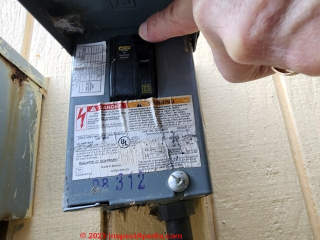
2. Open the box and inspect its interior for damage, loose connections, and debris.
Clean out the interior, and as the box is already loose, remove any remaining screws, taking great care not to nick or damage any of the electrical wires.
Watch out: pulling the wires around to get access to the box mounting screws can cause a twist-on connector to come loose: not only would this be very dangerous if you failed to turn off power, in addition if wires come loose it may not be obvious to you just which should be connected.
To avoid running into this trouble, if the installer hasn't already done so, for groups of wires that are connected together by a twist-on connector, we check that the connector is tight, and we use a bit of electrical tape to also tie that bundle of wires together.
3. Before re-mounting the box to the wall we clean the wall surface behind it, use fire-block foam to seal any holes drilled to pass wires if they were not sealed already, then we use an outdoor selant to waterproof the wire passages and any other damaged siding that will be behind the box.
4. Re-mount the box to the wall using exterior-rated screws
5. Use an exterior sealant (caulk) to seal the top edge of the electrical box against the wall. Sealing its sides is optional.
Do NOT add sealant along the underside of the box where it meets the wall. If any water gets into the space between the box and the wall we want it to be able to get out.
6. When pushing wires back into the box, bend them so that the twist on connector's opening is angled "down", and keep all of the connections above the bottom inch or so of the box. This keeps any connectors out of water that might enter the electrical box.
You may notice that some of these outdoor junction boxes contain an internal label with a line drawn on it -pasted along the bottom back wall of the box, and text noting that you should keep any "devices" above that line.
When those sealants are dry that's a good time to paint the wall behind the electrical box.
7. With the wall sealed behind the box and the box secured to the wall and the wires properly in place inside the electrical box, drip a dab of oil on the cover securing screw so that it won't be rusted solid fifteen years from now when you need to open it again. Then restore the box cover.
8. Restore power to the AC Circuit and confirm that your equipment is working normally.
9. Finish painting the wall around the box if that was what led you to this project in the first place
Here is a photo of the sealed top of the electrical splice box (left) and the electrical shutoff-switch for the outdoor HVAC condener unit after our reair.
On 2023-09-23 by Just-Wondering - are outdoor electrical boxes used to hold the wiring and shutoff for my condenser unit really waterproof?
I was just wondering if those weatherproof outdoor electrical boxes used to hold the wiring and shutoff for my condenser unit need any special considerations when they are installed:
are they really waterproof?
On 2023-08-06 by InspectApedia Publisher (mod) - A smaller (lower ampacity) fuse is always "safe" (but may be inadequate)
@John,
A smaller (lower ampacity) fuse is always "safe" in that it should blow (or breaker should trip) sooner than a larger or higher ampacity fuse or circuit breaker.
Of course if your local disconnect fuse or breaker is too small for the current drawn by the A/C compressor/condenser unit then it's going to blow or trip and your system won't work.
Watch out: if in the main electrical panel your installer used a larger amapcity breaker or fuse for the condenser unit circuit than was specified by the installation manual for the condenser unit itself then further investigation would be appropriate.
On 2023-08-06 by John - Do the fuses in the local disconnect need to be the same as theBreaker or can it be less?
Do the fuses in the local disconnect need to be the same as theBreaker or can it be less?
On 2023-01-28 by InspectApedia Publisher (mod)
@Anonymous 411,
Yep I've run into that situation too: unsafe conditions where there is no building code enforcement.
In my OPINION relying on codes is, too often for all of us an "easy way out" to try to get people to do what they should do anyway.
In this case if there's no higher authority, what you have left is to be very clear to building management that you are notifying them of a well-known, well-documented safety hazard - in writing, registered, notarized, return receipt requested or hand delivered and signed-for. That is a polite way of making clear who's going to be held responsible if a tragedy occurs and it can sometimes prompt people who otherwise are too over-worked and under-paid to take a second look.
On 2023-01-28 1 by Anonymous 411
@InspectApedia Publisher, the complex is located in a rural town which does not employ a Building Inspector, and is not required to do so by state law. Property Management's position has been "there is no building code."
As a result, I likely need to request state law changes due to the apparent gaps and/or inconsistencies. I will post a comment here if I get a response from the state. There is one other situation I may post if that's ok (possible missing disconnect switch). Thank You for your expertise, it's clarifying things a lot.
On 2023-01-28 by InspectApedia Publisher (mod)
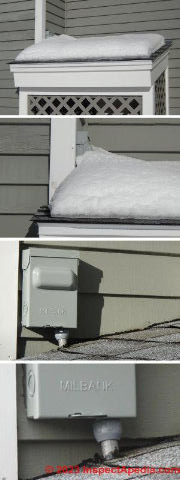 @Anonymous 411,
@Anonymous 411,
In my opinion the A/C Compressor/condenser unit shutoff controls shown in these photographs are not "readily accessible", but at the end of the day, the local building or electrical inspector is the final, local, legal authority.
We have the electrical code, your photos, your opinion, my opinion, and the position of your property management.
If you have notified your property managers IN WRITING that this is a questionable, hazardous, and possibly improper installation, and there's no reply and no action, what's left is to ask your local building or electrical inspector to look carefully at the site and give an opinion.
Let us know when you've taken those two steps and what results you obtain: that will help other readers.
The box on the left appears to be the disconnect switch for the Heat Pump.
There are winter/summer photos taken at the same location.
The box is about 3-5 inches over the roof, and around 5.5 to 6 feet above the ground.
To access the box, a person has to lean against the shed on the left side, and reach up and around the corner to touch/open the box.
During winter, it's possible that the box can be buried under snow at times, and with repeated thawing and freezing, accumulated snow can have an ice layer on top and on bottom as snow compacts.
It is unknown if the snow can be pushed aside or has to be picked at with a tool to fully expose the box.
Is NEC/NFPA 70 440.17 violated due to the location of the box (readily accessible?), or because it can be buried/obscured by snow at times (not in sight at times)?
Any insight is appreciated. Thank You Again!
On 2023-01-26 by InspectApedia Publisher - reasons why enclosed pump and disconnect switch installation is unsafe
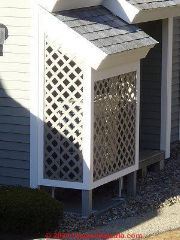 @Anonymous 411,
@Anonymous 411,
Well that photo is much more clear.
Unless those covers are hinged the shutoff isn't readily accessible nor is the equipment even for service.
Worse, Even with the lattice ripped off or hinged out of the way, I'm not sure that one could reach up under that roof to get to the shutoff
in an emergency.
That installation looks unsafe to me.
Why?
First, I think that almost any code compliance inspector or electrical inspector will agree that if it's necessary to unscrew even one, much less multiple, fasteners simply to reach a service shutoff switch, the installation is not code complaint (with the US National Electrical Code) as requiring dis-assembly to access a shutoff control is NOT "readily accessible".
Second, in a practical sense, there are two reasons one would need to access the shut-off for those outdoor compressor/condenser units:
- in normal service - the requirement that a shutoff be placed readily-accessible from the equipment it powers is intended as a safety feature, making it easy for the service technician to turn off electrical power when that's needed to work safely on the equipment -
that requirement, in my OPINION probably stems from the real-world recognition that if it's hard to turn off power, some technicians will, being pushed for time and productivity, be tempted to work on the equipment with power on - that is "live", increasing the risk of injury or death by electrical shock. - in an emergency, should the equipment be malfunctioning, perhaps catching on fire, as an urgent safety step, someone seeing that might want to turn off electrical power to the equipment to prevent a worse disaster, such as electric arcing that sets equipment or the building on fire - again a risk to human life as well as property loss.
Third and finally, as we have encountered firsthand in our own building service and consulting work, if, heaven forbid, there is a fire, injury, or death at your property, the second that your insurance adjuster sees that the equipment was not properly installed, was unsafe, and was in violation of the electrical code, you can figure that your insurance coverage may be considered null and void.
In some communities where code enforcement may be perhaps a bit more relaxed, I have also found that when a disaster occurs, you will never ever find the local code official standing up to be counted as having "approved" the installation.
Your property management people, on seeing this discussion, need to address these installations as soon as possible.
 On 2023-01-26 by Anonymous 411 - Heat Pump with electric box boxed into a shed
On 2023-01-26 by Anonymous 411 - Heat Pump with electric box boxed into a shed
@InspectApedia Publisher, your expertise is greatly appreciated. Yes, it's two photos combined into one
The top photo is of a Heat Pump with electric box before boxed into a shed, and the bottom photo is of a nearby pump.
The attached new photo is of the top pump AFTER it was boxed into a shed. Note that an empty firewood bin is adjacent to the shed.
To access the electric box, I believe the lattice has to be unscrewed and removed to expose the pump and electric box. There is a chance that the lattice can be pried or ripped out. I do not have access to the pump/electric box to photograph.
Can you please briefly describe why you believe the installation is unsafe? There are 17 or so Heat Pumps in my complex, with each installed differently depending on the contractor. All pumps are boxed into a shed with lattices as shown.
Your website is a great resource! I will post a question soon to your clearance page, and how it relates to IRC, a separate issue. Thank You.
On 2023-01-26 by InspectApedia Publisher - disconnect switch boxed into permanent sheds without easy access creates unsafe situation
@Anonymous 411,
Thank you for the disconnect switch access question - that's helpful.
I'm not sure if your photo is one image or a composite of two images.
But it looks to me as if there is an electrical box just above or behind and above an outdoor compressor/condenser unit, not behind a lattice enclosure.
If that box can be reached readily and if, as I expect, it contains a shut-off switch or pull-out connector that can drop power to the unit, the it complies with NEC/NFPA 70 440.17
But if as your question suggests, there is not ready access to the switch without having to remove that lattice enclosure then in my OPINION the installation does not comply with NEC/NFPA 70 440.17 and is unsafe to boot.
By opening the box cover (lift "up" then "out") you should see the disconnect means. Do post a photo of the electrical box interior.
On 2023-01-26 by Anonymous 411
This box appears to be the disconnect switch for the Heat Pump. NEC/NFPA 70 440.17 requires the disconnecting means to be Readily Accessible. Article 100 defines Readily Accessible as capable of being reached quickly without using tools or removing obstacles.
Heat Pumps here are being boxed into permanent sheds with a lattice about 12" from the face of the pump. The lattice is probably screwed into place, but possibly could be torn out by hand in an emergency.
Is this installation a NEC violation because the lattice obstructs access to the disconnect switch? After the lattice is removed, the switch is within sight of the Heat Pump of course. If the box isn't a disconnecting switch, or any other NEC issues, please let me know! TY
On 2020-12-01 by (mod) - copper pipes inserted in fuse clips: asking for fire or shock or death
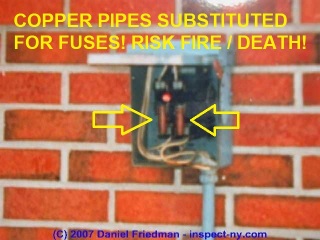 H
H
Watch out: Using a copper pipe where a cartridge fuse is required means that if there is an electrical problem such as overcurrent the wiring is not protected from overheating and setting the building on fire. The risk of replacing a fuse with a piece of pipe is fire or death.
On 2020-12-01 by HMH
Regarding the 1/2" copper pipes in place of fuses, doesn't that mean that there are large exposed chunks of metal at high voltage?
On 2020-10-01 - by (mod) -
Cssey
I have found no electrical code nor manufacturer's installation instructions that prohibit the use of a fuse pull out instead of a circuit breaker.
However it is important that the ampacity or rating of the wiring and fuse or over current protection be the proper size for the equipment including any new equipment being installed.
On 2020-10-01 by casey powell
Question: my old AC condensor is fed by a line from the house side of the meter to a fused disconnect (the kind you pull the fuse holder out to connect/disconnect). I'm replacing the unit with a new one. my local contractor and building department(Beverly Hills, MI) tells me the power feed must be changed to feed from a breaker in the service panel to the disconnect. Is that accurate? And if so, why?
Thank you
Casey
On 2020-08-03 by Mark Hillstrom
Can the air conditioner disconnect switch be located directly behind the condenser, or does it need to be to one side, or raised several feet above?
On 2020-06-29 by Anonymous
Not given explicitly
On 2020-06-29 by Bob
What is the minimum distance for an exterior AC Compressor breaker box and a water hose bib?
On 2020-06-25 - by (mod) -
Anon
A clearance distance between the AC Compressor/Condenser unit and "electrical service" (perhaps you mean the electric meter or service entry) is not given explicitly in the model codes, but there are required clearance distances and working distances.
Please take a look at CLEARANCE DISTANCE, HVAC
and let me know if you have further questions.
Thanks for asking.
On 2020-06-22 by Anonymous
Is it code in most states for ac compressor to be a certain distance from the electrical service?
On 2020-06-25 - by (mod) - AC condenser unit distance to electric meter?
Anon
A clearance distance between the AC Compressor/Condenser unit and "electrical service" (perhaps you mean the electric meter or service entry) is not given explicitly in the model codes, but there are required clearance distances and working distances.
Please take a look at CLEARANCE DISTANCE, HVAC
and let me know if you have further questions.
Thanks for asking.
On 2020-06-22 by Anonymous
Is it code in most states for ac compressor to be a certain distance from the electrical service?
On 2020-05-31 - by (mod) - my AC was not coming on in the house
Kevin
I'm of course worried about guessing when I'm not clear what's happening, but in general, sure all circuit breakers for the AC system need to be in the ON position.
On 2020-05-30 by Kevin
I noticed in the late afternoon that my AC was not coming on in the house. It was working fine just the night before and into the early morning. As the day progressed I noticed it was getting hotter in the house. I went to check the thermostat and it was completely blank.
So, I checked all the breakers.. they all seemed fine. There are two beaker boxes on the wall outside by the unit fan.. One looks like it gives the main power but then there is another one...
The main breaker was on.. but the other one was off. I reset them both.. then checked to see if the thermostat had come back on... it had not. So, I went and purchased a new thermostat. The original thermostat was not battery powered.
The new one was battery powered. I made sure to connect all the wires back properly. I finished the unit assembly. Then I turned the breaker the unit back on..
I was expecting the unit to come on, but of course with my luck it did not come on. I checked the fuse on the electrical panel in the main board of the unit, it was fine too. So, does both breakers outside need to be in the on position, and why does the unit still not come on with the replacement thermostat? Any Clues?
On 2020-05-10 - by (mod) - AC distance from breaker box
Ernest:
Sure, I don't see the issue, but may be I'm missing something in your question.
If you mean, not the main electrical panel but rather the service switch for the AC compressor, the switch has to be readily-accessible and in line of sight view from the compressor unit. Beyond that, any question of distance is in the purview of your local code inspector.
On 2020-05-10 by Ernest
I want to install an ac compressor that is 25 feet from my breaker box. Is that allowed?
On 2020-02-18 - by (mod) - can you put a disconnect before the panel and then use the same disconnect to power up your ac
Eric
If I understand your question correctly, you're feeding an A/C unit from a main disconnect switch ahead of the main panel.
No don't do that.
The ampacity of the main disconnect will be sized to match the ampacity of the electrical panel, not the ampacity of the A/C unit.
For example if your main panel is 100Amps, the main disconnect will be a 100A switch.
But the A/C unit will typically be a 30A or 40A 220V device fed by wires rated to carry 30A or 40A. If you feed that wire and that AC unit from a switch that is rated to allow 100A you are not providing proper over-current protection to the AC unit nor to the wiring that supplies it.
The risk is an electrical fire, injury, or worse.
On 2020-02-18 by Eric
By code can you put a disconnect before the panel and then use the same disconnect to power up your ac unit then feeds your panel
On 2020-01-08 - by (mod) -
Jim
The "code" won't address re-using old components;
A practical answer is that if the replacement parts fit inside the old enclosure with adequate clearance then there's no reason not to-reuse the old disconnect box enclosure except perhaps cost; in at least some cases the added labor and the cost of replacement internal parts may be higher than if the disconnect is simply replaced with a new, already-assembled unit.
On 2020-01-08 by Jim
Can a new A/C disconnect box be installed in the old box already mounted to the wall per national electrical code
On 2019-10-28 - by (mod) -
You mean height from the roof surface? I expect it needs to be above possible snow height, must remain accessible, and must be in view of the HVAC equipment.
On 2019-10-24 by Jason
Is there a minimum distance required for a disconnect off of a flat roof? Disconnect is for a condensing unit.
On 2019-10-28 by (mod) - minimum distance required for a disconnect off of a flat roof?
You mean height from the roof surface? I expect it needs to be above possible snow height, must remain accessible, and must be in view of the HVAC equipment.
On 2019-10-24 5 by Jason
Is there a minimum distance required for a disconnect off of a flat roof? Disconnect is for a condensing unit.
On 2019-09-07 by (mod) - are all 20amp breakers the same or are some specific to air condition circuits - HACR or HVACR-Rated Circuit Breakers
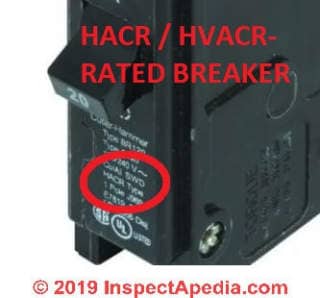 Re-Posting:
Re-Posting:
trevose rd said: are all 20amp breakers the same or are some specific to air condition circuits
Moderator Reply:
Trevose
RE: Are special HVAC-R rated or HACR-rated circuit breakers required for air conditioners and heat pumps?
Short answer: NO you don't need a special circuit breaker for your air conditioner: all circuit breakers sized for use on residential air conditioner units will be suitable. That's because virtually all such circuit breakers are already rated and approved for that use by having qualified / tested under UL 489.
For example Eaton Cutler Hammer, a producer of circuit breakers, says in their catalog, "All products 15-100A are HACR rated." (Source: Cutler-Hammer Miniature & Molded Case Circuit Breakers [Catalog] March 1999, retrieved 2019/09/07, original source: www.eaton.com/ecm/groups/public/@pub/@electrical/documents/content/pg74a01te.pdf)
While you may find a reference to an HVACR-Rated circuit breaker, or HACR-circuit breakers (to use the right acronym), provided the circuit breaker for your air conditioner is properly-sized, ANY conventional breaker will work fine.
When the electrical circuit for a compressor/condenser unit for an air conditioner or heat pump or refrigeration system is protected by a fuse, a special "slow-blow" fuse was installed to prevent nuisance fuse blowing during the initial high-current draw when those motors first started-up.
On changing to use circuit breakers (not fuses) in that application, to tolerate the turn-on current surge, PREVIOUSLY some circuit breakers were designed and tested specifically for their ability able to handle HVAC equipment power-on without nuisance tripping - to act like that "slow blow" fuse.
But that's no longer the case. In the U.S, Section 7.8 of the 11th edition of UL 489 granted HACR listing to ALL UL 489 Listed circuit breakers. Therefore there is no longer a requirement for special testing.
In sum, you don't need a "special" circuit breaker for your air conditioner because now ALL circuit breakers with a UL 489 listing are suitable for group motor applications requiring that HACR designation.
I emphasize "properly sized" because air conditioner compressor motors cause a brief surge in current flow at the moment of start-up that can trip the breaker.
For that reason, while a typical AC compressor unit might be wired for 30-Amp 240VAC the electrical codes permit installing of a circuit breaker one size larger (say 35A or 40A) to prevent nuisance tripping.
Take a look at the data tag on your air conditioner compressor/condenser unit, and use the Add Image button to add a sharp photo of it here.
I'll look at your data tag and together we'll doubtless see what circuit breaker is permitted.
However at least some of the circuit breaker manufacturers still make a point of LABELING certain of their breakers as HACR-rated.
Siemens provides a list of HACR-qualified circuit breakers at www.schneider-electric.us/en/faqs/FA230479/ but pretty much every modern circuit breaker has to meet UL 489.
Click to enlarge the circuit breaker label shown below and you'll see the HACR-rating
This Q&A were posted originally at InspectApedia Policies - https://inspectapedia.com/Admin/InspectApedia_Policies.php
On 2019-08-07 by (mod)
The 3 ft. might be fine but there's more to service disconnect distance: The distances between the condenser unit and the service or shutoff switch also require that the shutoff be "line of sight" and "readily accessible"
On 2019-08-07 by Kenny Smallwood
Can electric be ran to outdoor condenser without disconnect as long as electric panel is outside within 3 feet
On 2019-06-27 by (mod) -
With the ducking and weaving that comes with not being able to actually see the installation that you're talking about and a warning that of course there could be something there that is unsafe, I haven't found any restriction that prevents locating an emergency shut-off for an air conditioner outside compressor condenser unit below a window.
On 2019-06-27 by Red
Can a 40amp ac disconnect be located under a working window
On 2018-05-29 by (mod) -
Hi Joe, nice to hear from you. I am nervous answering a question from an educator who knows more than I do, but here's my OPINION:
MAYBE:
Regulations for safety disconnect switch location require that the switch be readily-accessible. If in a particular case, locating the disconnect behind the condenser unit has jammed it into a location that would not be readily accessible then that location is improper.
There has been a lot of chatter about where the switch must be, including just what is meant by "readily accessible" to include - within line of sight.
The intention of the electrical code such as NEC 440.14 (also see NEC 430.102) for these switches is two fold
1. having a switch that's readily accessible reduces the temptation of some techs to work on equipment live, hopefully reducing shocks and fatalities. It can be some distance away but must be visible from the A/C unit. There is a similar rule for room air conditioners that adds - Within 6 ft. of the floor.
2. in an actual emergency that might occur during service (this happened to me on a heating repair job) you want the tech to be able to turn the system off immediately - like "HELP MY TIE IS CAUGHT IN THE FAN"
I would add that IF the installer put the shut off for the condenser unit behind the unit, presumably on a building wall, such that there is so little space that it can't be easily operated, then I suspect that the unit itself is improperly-located. Even for the side of a condenser unit that doesn't need air intake/exhaust and that is not removed for service, typically the manufacturer is going to require it to be 12" or more from the wall.
Can you show me a photo of the switch and condenser in question?
My photo below shows a unit that is too close to the wall and is tipping, but it's disconnect is readily accessible to one side.
IMAGE LOST by older version of Clark Van Oyen’s useful Comments code - now fixed. Please re-post the image if you can. Sorry. Mod.
On 2018-05-29 by (mod) - regulation that requires the electric disconnect switch to not be located behind the exterior condenser unit?
Hi Joe, nice to hear from you. I am nervous answering a question from an educator who knows more than I do, but here's my OPINION:
MAYBE:
Regulations for safety disconnect switch location require that the switch be readily-accessible.
If in a particular case, locating the disconnect behind the condenser unit has jammed it into a location that would not be readily accessible then that location is improper.
There has been a lot of chatter about where the switch must be, including just what is meant by "readily accessible" to include - within line of sight.
The intention of the electrical code such as NEC 440.14 (also see NEC 430.102) for these switches is two fold
1. having a switch that's readily accessible reduces the temptation of some techs to work on equipment live, hopefully reducing shocks and fatalities. It can be some distance away but must be visible from the A/C unit. There is a similar rule for room air conditioners that adds - Within 6 ft. of the floor.
2. in an actual emergency that might occur during service (this happened to me on a heating repair job) you want the tech to be able to turn the system off immediately - like "HELP MY TIE IS CAUGHT IN THE FAN"
On 2018-05-28 by Joseph Scaduto
Is there a regulation that requires the electric disconnect switch to not be located behind the exterior condenser unit?
On 2017-07-18 by (mod) -
It depends on type & capacity, $5 TO $150
Watch out: do not try working in an electrical panel as you could cause a fire or be killed
On 2017-07-17 by rainsgwendolyn3@gmail.com
My landlord took pull out circuit braker out of unit outside how much do they cost
Question: replace the cover or door of an A/C cutoff box
(Sept 7, 2016) Nola said:
Can I buy just a door for a/c cut off box
Reply:
If you are referring to an indoor or outdoor electrical power switch, check with your local electrical supplier.
If you are referring to the compartment cover or door of an air handler, possibly so, if you can read the manufacturer's name and box model number, just give the manufacturer a call.
Other electrical switches and controls such as an air conditioner or heat pump pressure safety switch found on or near the compressor/condenser unit and in some window and through-wall units can also shut down an air conditioner or heat pump system, as we discuss below in this article.
- Air handler service switch
inside on or close to the air handler unit: usually mounted on the outside of the air handler, or possibly on a wall nearby.
Often the switchplate on these is red and on occasion it may be mis-labeled as "heat" in white print on red background, depending on where someone found the switch plate. (Photo above). - Air handler blower compartment safety switch:
a safety interlock that will turn off electricity to the air handler or blower unit if the blower compartment door is not securely shut.
If your air conditioner blower will not start this switch and the blower compartment doors should be checked.
See BLOWER FAN OPERATION & TESTING - Air conditioner/heat pump contactor relay switch:
turns on high amp drawing equipment such as the compressor motor.
See CONTACTOR RELAY DIAGNOSIS & REPAIR - Air conditioner or heat pump pressure control & pressure safety switches:
turns off the system at excessive refrigerant pressure and in some systems at too-low pressure. Also used in automotive air conditioning.
See PRESSURE CONTROLS & SAFETY SWITCHES - Electrical panel circuit breakers or fuses
will be provided separately to control the air handler (blower system) circuit and the compressor/condenser circuit. Of these the compressor is usually supplied by a 240V circuit and the air handler by a 120V circuit.
...
Continue reading at CONTROLS & SWITCHES, A/C - HEAT PUMP or select a topic from the closely-related articles below, or see the complete ARTICLE INDEX.
Or see A/C HEAT PUMP CONTROL / SWITCH FAQs - questions & answers posted originally on this page
Or see these
Recommended Articles
- A/C - HEAT PUMP CONTROLS & SWITCHES
- CIRCUIT BREAKER SIZE for A/C or HEAT PUMP
- OPERATING CONTROLS, A/C & HEAT PUMP thermostats, zone dampers, and circuit breakers on air conditioners and heat pump systems.
- LOST COOLING CAPACITY
Suggested citation for this web page
COMPRESSOR DISCONNECT SWITCH at InspectApedia.com - online encyclopedia of building & environmental inspection, testing, diagnosis, repair, & problem prevention advice.
Or see this
INDEX to RELATED ARTICLES: ARTICLE INDEX to AIR CONDITIONING & HEAT PUMPS
Or use the SEARCH BOX found below to Ask a Question or Search InspectApedia
Ask a Question or Search InspectApedia
Try the search box just below, or if you prefer, post a question or comment in the Comments box below and we will respond promptly.
Search the InspectApedia website
Note: appearance of your Comment below may be delayed: if your comment contains an image, photograph, web link, or text that looks to the software as if it might be a web link, your posting will appear after it has been approved by a moderator. Apologies for the delay.
Only one image can be added per comment but you can post as many comments, and therefore images, as you like.
You will not receive a notification when a response to your question has been posted.
Please bookmark this page to make it easy for you to check back for our response.
Our Comment Box is provided by Countable Web Productions countable.ca
Citations & References
In addition to any citations in the article above, a full list is available on request.
- Trane Corporation, "TUX-D-2 Upflow/Horizontal Left Downflow/Horizontal Right Condensing Direct Vent Gas Fired Furnace XR90 TUX040-series, single-stage fan assisted combustion system" from Trane, retrieved 11/5/2014, original source: http://www.trane.com/commercial/uploads/pdf/1112/tux_c.pdf
- Thanks to Alan Carson and Bob Dunlop, Carson Dunlop, Associates, Toronto, for permission to use illustrations from their publication, The Illustrated Home which illustrates construction details and building components. Carson Dunlop provides home inspection education, publications, report writing materials, and home inspection services. Alan Carson is a past president of ASHI, the American Society of Home Inspectors.
- Thanks to Lester Richer, a professional home inspector, for the reminder that a bad air conditioner condensate drip tray switch can shut the whole system down.
- Behr Hella Service A/C pressure switches,
- Grainger, http://www.grainger.com/
- Ranco Corporation, http://www.invensyscontrolseurope.com/ranco/ Tel (Europe) +44 (0)845 130 5522
- Sensata Technologies, 529 Pleasant Street, B41 Attleboro, MA 02703-2964 Phone: 1-248-692-5600 Fax: 1-248-692-5630 Email: auto-mktg@sensata.com Web: www.sensata.com, pressure switches for automotive air conditioning systems
- Micro Pneumatic Logic, Inc., Pompano Beach, Florida Tel. (954) 973-6166 - pressure switches
- Modern Refrigeration and Air Conditioning, A. D. Althouse, C.H. Turnquist, A. Bracciano, Goodheart-Willcox Co., 1982
- Principles of Refrigeration, R. Warren Marsh, C. Thomas Olivo, Delmar Publishers, 1979
- Refrigeration and Air Conditioning Technology, 5th Ed., William C. Whitman, William M. Johnson, John Tomczyk, Cengage Learning, 2005, ISBN 1401837654, 9781401837655 1324 pages
- In addition to citations & references found in this article, see the research citations given at the end of the related articles found at our suggested
CONTINUE READING or RECOMMENDED ARTICLES.
- Carson, Dunlop & Associates Ltd., 120 Carlton Street Suite 407, Toronto ON M5A 4K2. Tel: (416) 964-9415 1-800-268-7070 Email: info@carsondunlop.com. Alan Carson is a past president of ASHI, the American Society of Home Inspectors.
Thanks to Alan Carson and Bob Dunlop, for permission for InspectAPedia to use text excerpts from The HOME REFERENCE BOOK - the Encyclopedia of Homes and to use illustrations from The ILLUSTRATED HOME .
Carson Dunlop Associates provides extensive home inspection education and report writing material. In gratitude we provide links to tsome Carson Dunlop Associates products and services.


